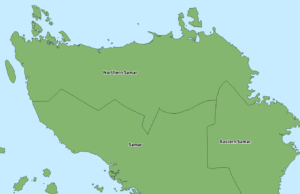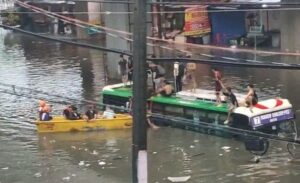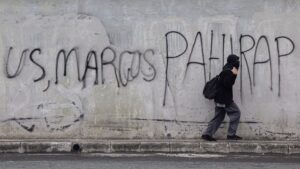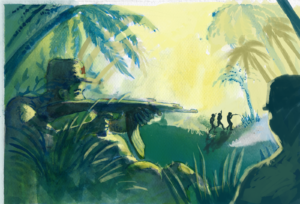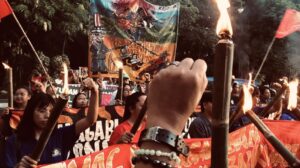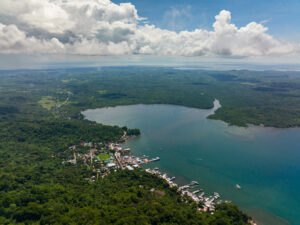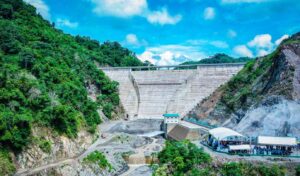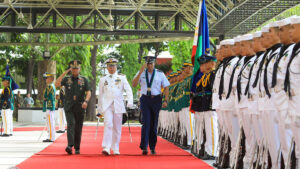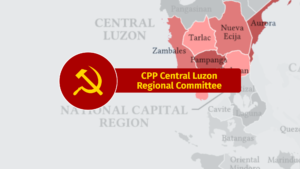kites Editorial Committee Interview with CPP Founding Chairman Jose Maria Sison
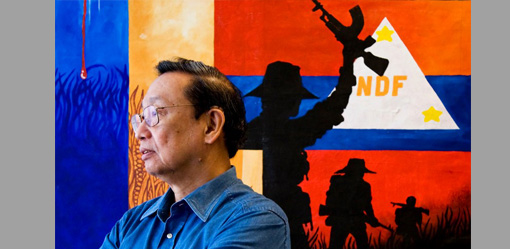
An Interview with Jose Maria Sison, Founding Chairman of the Communist Party of the Philippines
Commissioned by the kites Editorial Committee (September 2022)
Editorial Introduction
In September 2022, kites had the pleasure of interviewing Jose Maria Sison, the Founding Chairman of the Communist Party of the Philippines (CPP), which was founded in December 1968 and which went on to found and lead the New People’s Army in the people’s war that was launched in March 1969. In 1974, Sison was captured by the Ferdinand Marcos dictatorship and faced years of torture and solitary confinement before being released in 1986 after the overthrow of the Marcos dictatorship. In 1988, Sison was forced to seek asylum in the Netherlands after the Philippine reactionary government canceled his passport while he was abroad on a speaking tour.
Sison obtained recognition as political refugee from the Dutch Council of State since 1992, and has since enjoyed the protection of the principle of non-refoulement under the Geneva Refugee Convention and Article 3 of the European Convention on Human Rights, thus preventing his deportation to the Philippines or any third country.
While the people’s war continued and its underlying causes worsened, Sison has faced repeated attempts at legal harassment and repression during his forced exile: he has battled and defeated in the Dutch court system trumped up charges of multiple murder that were filed against him in 2007—charges that were instigated by the US-Arroyo regime in the Philippines. Sison later won a separate case before the European Court of Justice to have his name removed from the EU terrorist list, where it was placed in 2009. As he told kites in preparation for this interview, “I am legally clean and there is no hindrance to my freedom of thought and expression.” In defiance of the attempts to suppress his political thought and activity, Sison remains highly active as a public intellectual against imperialism and in defense of the socialist cause, as well as serving in the capacity of Chief Political Consultant for the National Democratic Front of the Philippines. Sison lives in Utrecht, Netherlands with his comrade and wife Julie de Lima, surrounded by a community of supporters and friends of the Philippine national democratic movement.
Interview
1. kites: This is an important time to be conducting this interview: the new Marcos-Duterte administration linking the two reactionary and despotic regimes together makes the people’s war in the Philippines increasingly relevant and urgent, despite the howls of the defenders of the old system. Revolutionaries and those who aspire to be revolutionaries around the world have much to learn from more than 50 years of revolutionary transformation, struggle, rectification movements, and the discipline and determination of the revolutionary people being born in the Philippines, their vanguard, the Communist Party of the Philippines, and its New People’s Army and the National Democratic Front of the Philippines.
Comrade, we want to start with your authorship of Philippine Society and Revolution or “PSR” over five decades ago, which we understand has been the go-to introduction for all levels of the Filipino revolutionary movement to understand the basic problems of the Filipino people and their resolution in People’s Democratic Revolution. For those of us outside the Philippines, PSR stands as an exemplary model of Marxist historical materialism. How was the writing of PSR related to the re-founding of the Communist Party of the Philippines (CPP) in 1968? How long did the research and production of PSR take? What was the relationship between the execution of this project to the break from the revisionist Partido Komunista ng Pilipinas (PKP) led by the Lava clique?
Jose Maria Sison: My study of the history and social circumstances of the Filipino people and the old Communist Party of the Philippine Islands1 started in the latter half of the 1950s. When the time came in 1966 for my comrades and myself to separate ourselves from the Lava revisionist clique which was in control of the old party, we gave priority to the research for and drafting of the rectification documents, “Rectify Errors and Rebuild the Party,” the CPP Constitution and the “Program for a People’s Democratic Revolution” for the purpose of reestablishing the CPP on December 26, 1968.2
After the reestablishment of the CPP, I proceeded immediately to the researching for, outlining and drafting of Philippine Society and Revolution (PSR) from May to August 1969. PSR was urgently needed to elaborate on the history, problems and revolutionary program of the CPP, proletariat and entire people. I let comrades read and critique the drafts until October and within the last week of that month the PSR was ready for mimeograph printing chapter by chapter by the CPP Central Publishing House.

PSR completed the process of laying the ideological and political foundation for reestablishing the CPP and resuming the people’s democratic revolution through protracted people’s war. We seized completely the revolutionary initiative from the Lava revisionist clique by producing such a book on the history of the Filipino people (Chapter 1), the basic problems of the people (Chapter 2) and the people’s democratic revolution as solution (Chapter 3) and by founding the New People’s Army on March 29, 1969.
2. You identify that the modern Philippines as a nation took shape both through the process of Spanish colonization and in resistance to that colonization, writing of the “great revolutionary tradition among the Filipino people.” What is the legacy of this great revolutionary tradition with the contemporary revolutionary movement in the Philippines?
We owe to the Philippine revolution of 1896 the legacy of the Filipino people’s revolutionary struggle for national independence against colonialism and for democracy against feudalism and medievalism. But this old democratic revolution led by the liberal bourgeoisie was defeated by the war of aggression unleashed by US imperialism from 1899 onward, after pretending to assist the Aguinaldo government against Spanish colonialism.

The CPP has vowed to continue the Filipino people’s struggle for national and social liberation as a new democratic revolution no longer under the class leadership of the liberal bourgeoisie but under that of the working class in consonance with the world era of modern imperialism and the world proletarian revolution. The new democratic revolution aims to defeat imperialist domination and the local exploiting classes of big compradors, landlords and bureaucrats and proceed to the socialist revolution.
3. How has the continued resistance of the Filipino masses to colonization and imperialism—from Spain, to the US, Japan, the US again and now both the US and China—affected the development of the revolutionary and communist movement?
The series of foreign dominations over the Philippines by Spanish colonialism, Japanese fascist occupation and US imperialism plus the recent military bases of Chinese imperialism in the West Philippine Sea has imposed a series of problems detrimental to the Filipino people, especially the toiling masses of workers and peasants. But at the same time, the Filipino people have also learned comprehensively and profoundly to wage a series of revolutionary struggles against these foreign monsters.
The CPP and other revolutionary forces of the Filipino people have learned and achieved so much from these struggles that they have been able to build an armed revolutionary movement that is nationwide and intimately connected with the toiling masses of workers and peasants. After 53 years of continuous struggle, the Philippine revolution has accumulated unprecedented strength beyond the levels of strength previously achieved since the Philippine Revolution of 1896.
4. How did you come to the analysis that the Philippines is semicolonial and semifeudal, with the three basic problems of imperialism, feudalism, and bureaucrat capitalism? How did that analysis differ from the analysis of the Lava clique?
The Philippines remains semicolonial because it has not yet realized full national independence. Since the 1946 nominal grant of independence, US imperialism has always made sure through unequal treaties, agreements and arrangements that the Philippines is politically, economically, culturally and militarily subservient to the dictates of the US. The Filipino exploiting classes and their ruling system are subordinate to US imperialism against the national and democratic rights of the Filipino people.
The Philippines also remains semifeudal in economic and social terms. Feudal and semifeudal relations persist. In fact, feudal landlord-tenant relations cover more poor peasants and farm workers and hectarage than the semifeudal relations in plantations run by agro-corporations which have a limited number of regular wage-earning farm workers and hire low-paid seasonal farm workers only during peak harvest seasons. As a whole, the Philippine economy is run by the big comprador-landlord combine rather than by an industrial capitalist class despite the dominance of the commodity system of production and distribution since the 19th century.
The Lavaite revisionists could not understand how Mao earlier and I later explained that imperialism or foreign monopoly capitalism has used feudalism as social base. The great number of people impoverished by feudal and semifeudal relations serve to provide cheap labor for any enterprise of foreign investors or big compradors, produce cheap raw materials and exotic fruits for export, consume manufactures from imperialist countries and so on. Like the Mongols, the Spanish colonialists and US imperialists make up for their shortage of personnel by using puppets among the local rulers. That should explain easily how imperialism takes advantage of feudalism as social base.
Foreign rule in the Philippines has always relied on local puppets, from the central level to the local level. So under semicolonial conditions the foreign ruler makes use of the landlord class-based politicians to run the whole country. This shows that the landlords, as well as the big compradors who are related to the landlords, help US imperialism run the country. Thus you can easily see that the landlord and big comprador base is the real base of imperialism.
5. What is your assessment of why the basic analysis of the Philippines as semifeudal and semicolonial remains true, despite major social and economic transformations since the time you wrote PSR, and why has this been controversial to some? What, if anything, has changed in the material basis of Philippines society since the writing of PSR?
I have already explained that the Philippines remains politically semicolonial or if you wish neocolonial, grossly lacking full independence and principally subservient to US imperialism. Now, let me focus on the economic and social term semifeudal. Let me quote a few paragraphs from my article “Semifeudalism in the Philippines” to give you an initial idea of semifeudalism and then please proceed to read the entire article:
The agriculture, industry and service sectors of the Philippines are all dependent on the importation of capital goods as well as intermediate goods in varying degrees in order to operate. These include mechanical, electro-mechanical and electronic equipment, fuels, metals, chemicals and agricultural inputs. They are required to optimize production in the semifeudal economy.

The importation of these capital goods is paid for by the exportation of certain agricultural crops, mineral ores, semi-manufactures and cheap labor in the form of live men and women. These exports are however never enough and there is a perennial and growing trade deficit which is paid for with mounting foreign debt and direct investments which only entrench and worsen the problem.
The Philippines lacks an industrial foundation and cannot be considered industrial capitalist, despite the baseless claim of bourgeois economists that it has become a newly-industrialized country. It has rich mineral resources but these are merely extracted and exported to industrial capitalist economies. It has not developed metallurgy beyond the stage of primary processing or the mere extraction of mineral ores and it has no capacity for producing steel and other basic metals, machine tools, precision instruments and other basic means of industrial production.
All sub-sectors of the industry sector (mining and quarrying, construction, refining of imported crude oil, assembly of cars and ships, electronic assembly, production of cement, chemicals and fertilizers, garments, industrial food and beverage processing, reshaping of imported plates, tubes and rods of steel and other metals, and so on) are grossly dependent on imported electro-mechanical equipment, fuel and components pre-fabricated abroad. In recent decades, imported industrial inputs began to include digital-tech tools dependent on expensive software and other heavily protected “intellectual property” such as patents, which are controlled by imperialist firms to prevent unauthorized technology transfer.
What is passed off as manufacturing in electronics and transport equipment (cars, trucks, motorcycles and ships) is merely assembly of finished parts and components from abroad. What is passed off as shipbuilding is mainly welding of parts prefabricated abroad. What is passed off as steel industry is merely the reshaping of imported metal plates, tubes and rods.
The relations of production describe best the semifeudal character of the Philippine mode of production. The chief ruling class is no longer the traditional rent-collecting landlord class of feudal times. It is the comprador big bourgeoisie, which is the chief financial and trading agent of foreign monopoly capitalism and owns the big banks, export-import companies, shopping malls, construction, real estate companies and the like. At the same time, it owns the largest haciendas and related agribusinesses, including livestock and poultry farms, fishing fleets, agroforestry schemes and stocks in mining companies to assure itself of primary commodities for export in exchange for the manufactures that it imports.
The comprador big bourgeoisie is often called the big comprador-landlord class to emphasize its semifeudal character, its hybrid character as merchant capitalist and feudal owner of haciendas. It engages in manufacturing but it imports the majority of its means of production, the fuel and most major components of the total product. It uses some amount of mechanization in its haciendas but continues to use the cheap labor of seasonal farm workers and collects from the widespread traditional rent-collecting landlords a large amount of agricultural surplus for local processing, domestic trade and export. It has the biggest amount of bribe money to determine the big comprador character of the high bureaucrat capitalists as well as the results of elections at the national, regional, provincial and city levels.3
6. Thank you for that clarification comrade. Let’s now turn to some other questions concerning the theory and practice of the Philippine revolution. In Specific Characteristics of Our People’s War (1974) you write about the challenges of waging protracted people’s war in a mountainous archipelago. How did comrades understand this challenge at the time of initiation of the people’s war, and what has been learned since then?
At the resumption of the people’s war in the Philippines in 1969, it was truly challenging that the New People’s Army had to grow from small and weak to big and strong in an archipelago where the main islands of Luzon and Mindanao are separated at the middle by a clutter of smaller islands called the Visayas. Some comrades complained that the NPA would have no wide spaces as in the Asian mainland for maneuverability, cross-border advantages or any long march similar to that of the Chinese in 1935 and 1936.
Specific Characteristics of Our People’s War allayed the fears of such comrades by pointing out that although the Philippines is archipelagic its mountainous character, the oppression and exploitation of the people and their historical experience of armed resistance can provide depth and breadth for the people’s army from one stage of development to a higher one. Thus, the general line was set for developing the people’s war in major islands first and then in the minor islands next. We developed first the armed struggle in the eleven major islands which carried 94 per cent of the entire Philippine population.
At first, the archipelagic character of the Philippines can be disadvantageous for the small and weak NPA. But in the long run the CPP, NPA, NDFP, the revolutionary mass organizations and organs of political power did their work to expand the armed struggle. After only the first ten years of people’s war, the NPA succeeded in spreading nationwide and developing strong links with the toiling masses of workers in most regions of the Philippines. Despite resorting to fascist dictatorship, the Marcos regime could not destroy the NPA but was instead overthrown in 1986.
The post-Marcos pseudo-democratic regimes engaged in campaigns of military suppression as well as in peace negotiations but failed to subdue the NPA. After 53 years of people’s war, the NPA has been able to build more than 110 guerrilla fronts in large areas of 74 provinces out of the 81 Philippine provinces. It has about 10,000 fighters with high-powered rifles and augmented by the people’s militia of the local organs of political power and self-defense units of the mass organizations. It has enabled the rapid growth of the revolutionary mass organizations, the alliance of patriotic forces and the people’s democratic government.
The victories of the NPA are enhanced by the fact that it has seen the futility and failure of the 14-year Marcos fascist dictatorship in trying to destroy it. The dictatorship served to outrage and inspire the people to wage armed and other forms of resistance. The brilliance of the victories of the NPA is enhanced by the fact these were won self-reliantly. The NPA had no cross-border advantages like the Chinese, Korean and Indochinese people’s armies had in the past. Worst of all the Dengist counter-revolution in China prevailed in 1976 or even earlier and cast away the principle of proletarian internationalism in favor of collaboration with US imperialism.
7. How does the National Democratic Front of the Philippines (NDFP) and the Filipino revolutionary movement understand the position of the Philippines as a nation oppressed by imperialism while containing within it various oppressed nations and indigenous peoples? What are the strategic possibilities generated by these oppressed nationalities, and how has the revolutionary movement historically navigated the challenges of fighting for autonomy within a larger revolutionary movement?
The oppressed nationalities and indigenous peoples in the Philippines amount to 15 per cent of the entire Philippine population but they occupy extensive areas of the Philippines which are hilly and mountainous. They include the Aetas (Negritoes), the various tribes of the Cordillera, the Muslim Moros of Mindanao, the Lumad, Mangyan of Mindoro, Tumandok of Panay and others. Historically, they have been more resistant to Westernization than the 85 per cent of Filipinos who live on the seacoast and along the big rivers and were more exposed to the Spanish and US colonial rules.
Since its foundation, the CPP has included in its Program for the People’s Democratic Revolution the following major point: “National minorities in the Philippines have been abused and grossly neglected. (They) can be powerful participants in the revolutionary overthrow of U.S. imperialism and feudalism… The main concern of the national minorities is land; the abuses of landlords, loggers and land-grabbers; and exploitation in mines and plantations. A new type of leadership, a revolutionary one must be encouraged to rise among them so as to supplant the traditional leadership that has failed to protect them and has merely contributed to and participated in their exploitation.”
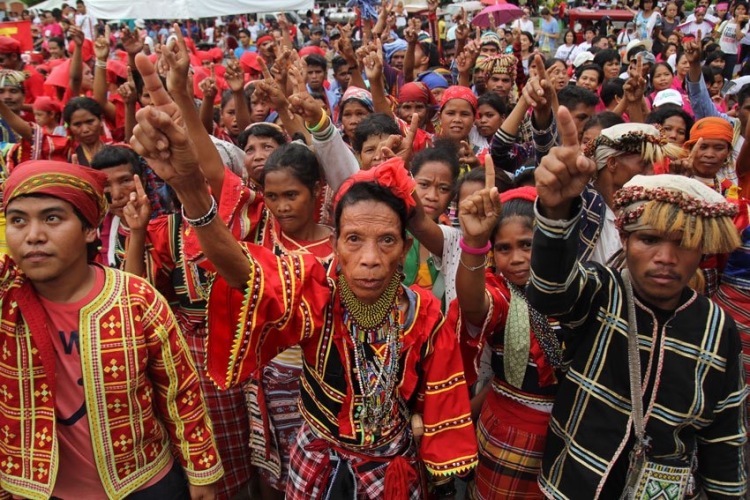
The CPP and the revolutionary movement recognized the right of the national minorities to national self-determination, including the right to autonomy in a non-oppressive Philippine state up to the right of secession against an oppressive state. The National Democratic Front of the Philippines has the following organizations of national minorities among its allied 18 organizations: Moro Resistance and Liberation Organization, the Cordillera People’s Democratic Organization and Revolutionary Organization of Lumads. The oppressed nationalities uphold their right to autonomy and other democratic rights within the NDFP framework and have played a major role in developing the people’s war and have made major contributions to the Filipino people’s struggle for national and social liberation.
8. Several years ago there was a call on the New People’s Army to re-build urban units to expand the reach of the revolution. Can you describe the current phase and stage of the protracted people’s war? Is expanding the reach of the revolutionary armed forces to the cities necessary to proceed to the stages of strategic equilibrium and strategic offensive? How will the construction of such urban units differ from the deviation in the 1980s away from protracted people’s war?
Within the last decade of the 20th century, the Second Great Rectification Movement (SGRM) was successful at repairing the serious damage done by the urban insurrectionist line in various regions and at further strengthening the guerrilla fronts on a nationwide scale and multiplying the NPA platoons and companies for the purpose of accelerating the maturation of the middle and advanced phases of the strategic defensive. Thus, the US and the Arroyo regime tried to carry out focused or concentrated offensives of the reactionary armed forces and police against a series of major guerrilla fronts.
The central leadership of the CPP thought of three ways to defeat the planned offensives of the enemy which eventually rolled out as Oplan Bantay Laya I, II amd III during the 10-year Arroyo regime. The first way was to welcome the enemy offensive with land mines and sniper teams, retreat the main force of the guerrilla, deprive the enemy of a prime target and observe how the enemy deploys his forces for the purpose of harassments and counter-offensive. The second way was for the NPA in other areas of the same guerrilla front and in other guerrilla fronts to launch their own offensives in order to distract the enemy and continue seizing arms. The third way was for the NPA to launch small but dramatic urban operations of the [Armed City Partisan]-type in order to further distract the enemy.
The first way proved successful in the long run in Mindanao and some other regions. The second way was slow, especially in the regions north of Manila. The organization of rural-based NPA units for ACP-type operations in the urban areas has been dormant or too slow until now probably because the regional and central organs of leadership have been unable to provide the command to coordinate the rural-based and urban-based regional leaderships. There might also have been a problem of defining the physical and personality targets on the basis of intelligence and prosecutorial collection of evidence as basis for arrest of die-hard enemies or punitive operations in urban areas by the NPA. The critique of conservatism covers these matters.
9. Since the Second Great Rectification Movement was commenced in the early-to-mid 1990s, the New People’s Army (NPA) has dramatically expanded its guerrilla fronts and its ability to withstand fierce repression and counter-insurgency campaigns, including psychological warfare and aerial bombings. To your knowledge as a consultant to the NDFP, how has the waging of guerrilla warfare changed in the recent periods, including confronting the widespread use of drones and helicopters? How has the NPA withstood 21st-century methods of counter-revolution, and what are the prospects for the advancement of the revolution in the coming period?
You are correct in saying that since the Second Great Rectification Movement in the 1990s the NPA has dramatically expanded its guerrilla fronts and its ability to withstand fierce repression and counter-insurgency campaigns, including psychological warfare and aerial bombings. But I think that when a guerrilla front is under attack by a superior enemy force, the NPA in the same guerrilla front should try to inflict sure damage to the attacking enemy force during its advance, encampment and withdrawal and should also be able to carry out its own offensives in the guerrilla zones previously opened up by mass work in order to increase the arms of the guerrilla front.
Of course, when a guerrilla front is under attack, the other guerrilla fronts should also take initiative of making their own offensives. And if already available, rural-based NPA teams can be deployed for arrest of enemy die-hards and punitive operations in the urban areas and along major highways. The clamor for various types of NPA offensives has been rising because of the so many campaigns of mass murders being committed by the reactionary military and police forces against innocent civilians and against old cadres of more than 70 years old who had participated in peace negotiations and retired from the battlefield under the terms of the GRP-NDFP Joint Agreement on Safety and Immunity Guarantees.
With regard to the question of guerrilla warfare in which the enemy uses drones and attack helicopters, I can refer to the victory of the Taliban against the US where despite the fact that the Taliban had no stingers to use against the drones, helicopters and other aircraft of the US and its puppets in Afghanistan from 2001 to 2021, the Taliban simply relied on its political work and its ground-to-ground firepower in order to destroy the US and puppet personnel and installations on the ground. Nevertheless, the NPA has so far withstood what you call the 21st-century methods of counter-revolution. Duterte has failed to destroy the NPA with his dependence on US high-technology for collecting and analyzing information, use of drones and attack helicopters, ground spies and ground troops.
10. The Philippines is one of the very few places in the world where initial forms of red political power exist, namely in those areas where the CPP and NPA have established People’s Democratic Governments. What is your understanding of the geographic and quantitative reach of those governments? Can you describe how the masses are brought into exercising political power?
In the guerrilla fronts of the CPP and NPA, the local organs of political power are established and constitute the people’s democratic government under the Guidelines for Establishing the People’s Government. They are committees which consist of representatives of the CPP, NPA and the revolutionary mass organizations of workers, peasants, youth, women and others. They elect their own executive officers.
They form sub-committees in charge in charge of planning and implementing public education and mass organizing, land reform, social and economic development, finance, cultural affairs, self-defense, disaster relief and environmental protection. The barangay residents and the members of the revolutionary mass organizations supporting the people’s government run into tens of millions in the entire country.
11. How should comrades internationally understand the election of Ferdinand Marcos Jr. and Sara Duterte? How does the electoral defeat of Leni Robredo position the liberal and other petty-bourgeois opponents of the Marcos-Duterte tandem? Does the return of a Marcos to the presidency present possibilities to expose the rottenness of the whole Filipino ruling class and expand the reach of the revolutionary movement, or does this latest election result widen the basis for reaction?
The grave crisis and rottenness of the semicolonial and semifeudal ruling system are manifested by the treasonous, brutal and corrupt presidency of Duterte and the installation of Marcos junior as president and Sara Duterte as vice president through massive automated electoral cheating. Everyday that these usurpers of authority are in power, they are being discredited by their own dynastic records of treason, state terrorism and plunder and by the new wave of crimes of repression and plunder that they are committing,
The broad masses of the people will become more outraged than ever before and will condemn and resist the escalating conditions of oppression and exploitation. US imperialism expects Marcos junior to continue the Duterte policy of suppressing the revolutionary movement. He will certainly use the so called Anti-Terror Law to suppress the entire range of opposition in order to legalize the previous ill-gotten wealth of the Marcoses and accumulate more wealth at the expense of the people.
The toiling masses of workers and peasants who are the most oppressed and exploited will be driven to join the armed revolution for national and social liberation. The middle social strata of the urban petty bourgeoisie and middle bourgeoisie will be further encouraged to join the ranks of the patriotic and democratic forces. The reactionary classes of big compradors, landlords and bureaucrat capitalists will continue to split, factionalize and compete for the spoils in the ruling system and for the favor of the US and other foreign monopoly interests.
12. One of the exemplary features of the Philippine revolution and the CPP’s leadership is the continued practice of two-line struggle and rectification campaigns to stay on the revolutionary road. From your understanding, how have rectification campaigns helped the CPP stay on the revolutionary road, and how has the CPP navigated the inevitable splits and setbacks to avoid capitulation?
I agree with you that an exemplary feature of the Philippine revolution and the CPP’s leadership is the continued practice of two-line struggle and rectification campaigns to stay on the revolutionary road. Indeed, rectification campaigns have helped the CPP stay on the revolutionary road and have been able to prevent splits and setbacks from undermining and weakening the fighting will and capabilities of the revolutionary movement.
At the moment, the CPP continues to lead the Third Rectification Movement to combat conservatism. It admonishes against self-satisfaction and passivity with achievements in mass work, in raising resources for these and in having peace and calm in certain localities while others are under enemy attack. To be truly revolutionary in the current circumstances, all revolutionary forces and units and their CPP cadres and NPA commander can always find ways of raising their armed strength by fighting the enemy. The expansion of the mass base ought to enable more tactical offensives and provide more ways for security for elderly comrades who are already non-combatants but are being butchered by the cowardly enemy.
13. How has the Filipino movement sought to confront the postmodernism and anti-communism that is perpetuated in the bourgeois academy and is so prominent in movements of opposition in the imperialist countries, especially in North America? Do these ideas have strong purchase in the urban centers and amongst the petty-bourgeoisie and intelligentsia in the Philippines? If so, how have these manifested themselves against the Philippine revolution?
The cadres and social scientists of the CPP have constantly monitored, confronted and critiqued in publication and study sessions the various trends of subjectivist idealism, such as post-modernism and anti-communism, which are promoted in the bourgeois academies and on the internet in North America and Europe and are echoed to some extent by a few petty bourgeois intellectuals in the Philippines.
At any rate, there are relatively far more bourgeois reformists in the imperialist-funded nongovernmental organizations and Trotskyites and crypto-Trotskyites bred by their masters in various capitalist countries. I have recently done my bit of ideological combat by publishing the book, On the Philosophy of Marxism-Leninism-Maoism, and including my critiques of subjectivist idealism. I have also written articles on the Frankfurt school, Austrian school, French postmodernism, the British analytic philosophy and so on.
14. Now onto matters pertaining to the international situation. You have repeatedly pointed to the increasingly favorable objective situation for proletarian revolution in the world today. What are the subjective factors holding back the development of new revolutionary movements and parties?
I have repeatedly pointed out the rapid worsening crisis of the world capitalist system since the financial meltdown of 2008, the unraveling of the neoliberal and neoconservative policies of the US, the conspicuous US strategic decline, the big break between the US and China since the second decade of the 21st century and in recent years the upsurge of anti-imperialist and democratic struggles on a world scale as the prelude to the resurgence of socialism. The addition of two new imperialist powers (China and Russia) to the traditional imperialist powers has aggravated inter-imperialist contradictions and the crisis of the world capitalist system.
But we have to consider that real subjective factors, such as real communist parties, trade unions and other mass formations, people’s armies and other revolutionary forces must reemerge on a global scale through anti-imperialist and democratic mass struggles in order to make up for and supersede so many previous decades of revisionist betrayal and capitalist restoration in former socialist countries and the total discredit of so many revisionist parties and their variants outside of the Soviet Union, Eastern Europe and China.
After the Dengist counter-revolution in China from 1976 onward and the collapse of the Soviet Union in 1991, US imperialism and its followers declared the end of history with the supposed permanent death of socialism and the perpetuity of capitalism and liberal democracy. For some two decades since 1991, the US claimed to be the sole superpower for being winner in the Cold War and recklessly expanded the NATO and engaged in ceaseless wars. Now, the strategic decline of the US in a multipolar world is becoming more and more obvious after spending USD 10 trillion for wars of aggression.
15. Comrade, how do you assess the current state of inter-imperialist conflict and rivalry between the US and the rising imperialist power of China? What is your assessment of the increasing inter-imperialist conflict between the US and China in southeast Asia? How did the former Duterte regime play on this contradiction and is it any different from how the present Marcos-Duterte regime is orienting itself? Is there a possibility for the revolutionary movement to tactically take advantage of that conflict to advance itself?
The US-China inter-imperialist contradictions came to the surface during the Obama regime when the US complained against the economic and military rise of China and decided to carry out the strategic US pivot to East Asia and excluded China from the Trans-Pacific Partnership Agreement. The contradictions became even more conspicuous when the Trump regime started to cut down China’s exports to the US, shift US investments from China to other countries and accuse China of manipulating economic, trade and currency policies and stealing technology from US companies and research institutes.
The inter-imperialist contradictions between the US and China will become worse from year to year. In recent years, Duterte thought that if he sidled up to China and let it build artificial islands and military bases in the West Philippine Sea he could borrow from China USD 24 billion for infrastructure projects. But China delivered to him only a little over USD 1 billion. I think that the US will keep the Marcos regime under tighter control. Even in his last year in power Duterte had to prove utter subservience with the US and agreed to make Marcos junior the president by fraudulent vote count.
16. It is the view of kites that there are no socialist countries in the world today, a view we believe we share with the CPP. You have had favorable things to say about countries who have been in confrontation with imperialism such as Venezuela or Cuba. Do you view those countries as socialist?4
At this time, the CPP considers it very important to develop the international anti-imperialist united front and seek allies among countries that declare themselves as anti-imperialist and fully independent and as socialist (like the Democratic People’s Republic of Korea, Cuba, Vietnam and Venezuela) or as having socialist programs and aspirations. The CPP is happy to have relations with countries that consider themselves independent, anti-imperialist and willing to support the Philippine revolution.
It would be politically counterproductive for the CPP to pose publicly as the ideological arbiter of whichever countries are truly socialist or not. But the CPP keeps on studying from history and current circumstances what constitutes scientific socialism and what is the socialist perspective of the people’s democratic revolution. When the CPP wins the people’s democratic revolution, it will certainly announce how it shall start the socialist revolution in the Philippines. In the meantime, the CPP fervently wishes and hopes that more countries shall become socialist as a consequence of the growing anti-imperialist and democratic mass struggles.
The CPP wants to maintain the distinction between ideological and political tasks. By way of strengthening the vanguard party of the proletariat and the mass movement led by the communist party, ideological work has to be done on whatever scale of propagation that is [necessary]. Certainly within the scale of the Philippine party and the revolutionary mass movement the CPP would make sure that its performance of its ideological tasks does not destroy the accomplishments of the political task of developing relations of proletarian internationalism among genuine communist parties, as well as a solidarity alliance against imperialism among parties of all sorts. There’s no use trying to apply the ideological purity of Marxism-Leninism[-Maoism], which is applied within the party without a doubt, in conducting political relations with non-communist entities, especially at this time when there are no big socialist countries [in the world]. We are amidst a downturn of the accomplishments of the world proletarian revolution, and there is a need to ensure that we have a wide base for the resurgence of the socialist cause on a world scale.
17. You personally, and the Filipino revolutionary movement in general, including the CPP and NDFP, have had exchanges with a wide variety of organizations and movements, including some that we consider to be revisionist and which we consider to play an overall obstructive role in the emergence of a new generation of revolutionary parties. How should comrades internationally understand the exchanges of the Filipino revolutionary movement with such forces, and is there a responsibility of communists everywhere to shine a light on and polemicize against revisionism?
I have been abroad since the later part of 1986. And I have met with representatives of all sorts of parties. Within such a long period of more than three decades, some of them have retained or changed their ideological positions. Representatives of the CPP and the NDFP must have observed the same phenomena of persons and even entire parties changing their ideological positions.
In my experience as a Marxist-Leninist-Maoist, I was an active ant-revisionist participant in the Brussels Communist Seminar while it lasted from the 1990s to the early years of the 21st century. I was also the Chairman of the International Conference of Marxist-Leninist Parties and Organizations which propagated Marxism-Leninism-Mao Zedong Thought.
Then from 1998 to 2001, I chaired the International Preparatory Committee that established the International League of Peoples’ Struggle. I became its general consultant from 2001 to 2004 and then as Chairperson from 2004 to 2019. The ILPS has been basically an alliance of people’s organizations struggling for national liberation, democracy and socialism against imperialism, revisionism and all reaction.
18. Now onto some more personal questions, if you’d indulge us comrade. In addition to being a revolutionary writer, thinker, and leader, you’re an award-winning poet. What first motivated you to write poetry, who are your favorite poets, and would you select one of your poems to accompany this interview?
In the elementary grades, specifically in Grade 3, I became interested in reading and trying to write poetry. I was inspired by the poems my teacher asked me to recite. In high school at the Ateneo and Letran, I succeeded in having some of my poems published in the school publications. And of course, in the University of the Philippines, I published my poems in the Philippine Collegian and in various literary publications. I published by first book of poems in 1961, when I was 22 year old.
19. You are part of a proud generation internationally that took up the call from Mao Zedong to combat revisionism and build new communist parties on a revolutionary basis, including Abimael Guzman (Chairman Gonzalo), Charu Majumdar, and Ibrahim Kaypakkaya. To many around the world, these names resound as legendary and they continue to inspire revolutionaries today, but these were your contemporaries. What’s been the impact of the generation that merged the overall global upsurge of the 1960s with the leadership and guidance of Mao Zedong and Maoism? What does it mean to you to be part of that generational experience?
To say the least, we were a significant part of and had an impact on the generation that created the overall global upsurge of the 1960s with the leadership and guidance of Mao Zedong or Maoism. We wrote poems and performed other tasks, ideological, political and organizational, in order to generate the people’s democratic revolution with a socialist perspective in our respective countries. We became engaged in the revolutionary mass struggles and in waging the people’s war.
I consider myself the luckiest of those leaders you have mentioned because I have lived long enough to observe and study the rise of modern revisionism and neoliberalism for some decades, the unprecedented crisis of global capitalism and strategic decline of the US, the current upsurge of anti-imperialist and democratic mass struggles and the discernible transition to the resurgence of the socialist cause.
20. What sustained you during your period of incarceration and torture by the Marcos dictatorship?
I was sustained by the commitment to the just cause of serving the oppressed and exploited people in their struggle for national and social liberation. My studies of theory and practice of Marxism-Leninism-Maoism, my participation in the mass struggles and readiness to die anytime if necessary sustained me.
And of course, I composed poems to counter the psychological torture during my five years of my solitary confinement. These are in my book of poems Prison and Beyond which won the Southeast ASIA WRITE Award for poetry in 1986. I also kept my sense of humor and composed jokes against US imperialism and the Marcos fascist dictatorship.
21. What have been the most difficult experiences of your time in exile? Have there been unexpected joys as well?
My most difficult experiences included being deprived of employment since 1988 and even the living allowance for asylum seekers since 2003 while I was waging legal battles for political asylum after my Philippine passport was canceled in 1988, for the dismissal of the trumped up charges of multiple murder in 2007 and for the removal of my name from the EU terrorist list.
I won all these cases. And I enjoyed the support of my lawyers, the Filipino compatriots overseas and in the motherland and the organizations and institutions of foreign friends in solidarity with the Filipino people.
22. Warm evolutionary appreciations for giving this interview to kites. To conclude now, what sustains you as a revolutionary?
My commitment to the principles of the revolutionary proletariat and the just struggle of the Filipino people for national and social liberation.

ENDNOTES
1 This is the original name of the communist party in the Philippines that was founded in 1930. The name that the Lava revisionists continued to use to refer to their organization after the re-foundation of the CPP by Jose Maria Sison and his contemporaries is Partido Komunista ng Pilipinas (PKP).
2 These three documents can be found in the volume Foundation for Resuming the Philippine Revolution: Selected Writings, 1968 to 1972 by Jose Maria Sison (Netherlands: International Network for Philippines Studies, 2013).
3 “Semifeudalism in the Philippines,” October 3, 2020 (available at: josemariasison.org).
4 A note of self-criticism from the kites Editorial Committee: We should have worded this question differently to explain what we meant was socialist in the Maoist sense of a socialist transition to communism driven by ongoing class struggle.

